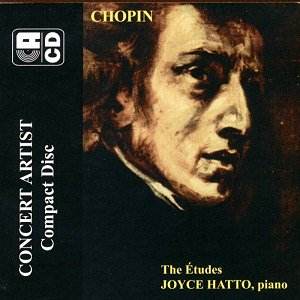The etudes of Chopin are one of the absolute
benchmarks of the pianistís repertoire. As a series of miniatures
they are almost without parallel for their range of emotional
content, breadth of technical coverage and exploration of tonal
centres in the 19th century repertoire of keyboard
music. While most are really quite short pieces (this recording
ranging from the maximum of Op.25 no 19 at just over five minutes
down to the brevity of Op.25 no 21 at but a second over one minute)
they cover such a gamut of feeling, power and expression that
there is endless potential for the imaginative pianist to communicate
something new to the listener within the confines of these rigidly
fashioned masterpieces. The Op.10 set date from 1831 (published
in 1832) and are (apart from nos 7 and 8) arranged in pairs of
relative major/minor keys. Yet this structural unification does
nothing to hinder the wide range of ideas and textures that Chopin
explores. The set published in 1837 as Op.25 had a longer gestation
period from 1832 through to 1836 and culminate in the powerfully
expressive numbers 7, 11 and 12. In these Chopin brought to bear
his most perfected skills of technical writing. Joyce Hatto is
in complete control of all aspects of these demanding works. Her
technique is impeccable and her range of expression is admirable,
although it is arguable whether she could have encompassed a wider
dynamic range in these interpretations. This may not necessarily
be the fault of the performer however, for the recording has some
rather strange qualities. It is noted that the piano is a Steinway,
and Steinways are ideal for this repertoire, being neither muddy
in the bass nor tinny in the upper registers and capable of producing
the most crystalline bell-like sounds under the fingers of a master.
This writer has no doubt that Hatto is capable of producing that
quality of sound; there are flashes of it throughout Op.10 no.11,
and in the powerfully controlled articulation of Op.25 no.10 but
too often the recorded sound is too distant, lacking in body and
brittle. This latter aspect gives a quality of the extreme brightness
of a Yamaha piano to the sound and detracts from the inherent
velvety smoothness of the Steinway sound. The opening track, the
first of the Op.10 études, gives a major surprise in this
brittleness of recorded sound. Given the nature of the constant
arpeggio figures in the right hand, set against the mighty octaves
of the left hand theme, the necessity of capturing both the clarity
and the sonority is paramount and this recording does not really
achieve that.
This is a pity for it is unarguable that Joyce
Hatto has much to say in these works. The brilliant Presto of
Op.25 no.2 is executed with flawless precision and a grace bordering
on Schumannís description of Chopinís own performance as "soft
as the song of a sleeping child" for, although that image
is hard to imagine in relation to the incredible speed, Hatto
here keeps the dynamic under strict control so that the rapid
passagework seems more to flutter than anything else. However,
once again the microphone placing gives a sound that seems distant
and curiously removed. This works better in a jerky work such
as Op.25 no.4, but generally it is not comfortable as a listening
experience.
This is a brilliant performance with many aspects
of sheer technical magic displayed in elegant virtuosity and characterful
interpretations, but the disc is sadly let down by the hard and
colourless and strangely disengaged recording quality. On that
basis it is regrettably not easy to recommend.
Peter Wells
See also review
by Jonathan Woolf
MusicWeb
can offer the complete
Concert Artist catalogue
